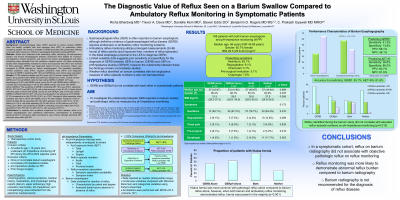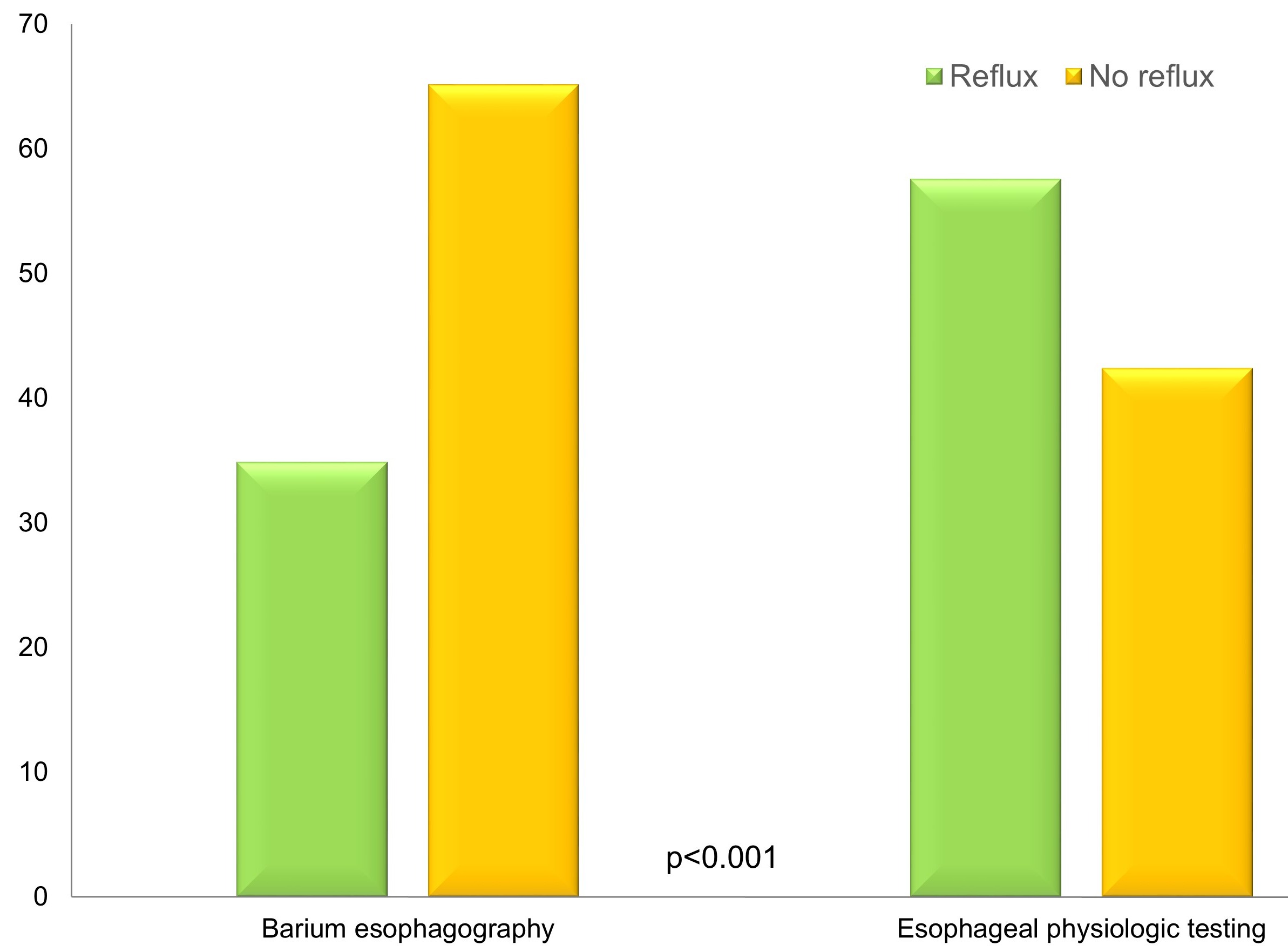Tuesday Poster Session
Category: Esophagus
P3248 - The Diagnostic Value of Reflux Seen on a Barium Swallow Compared to Ambulatory Reflux Monitoring in Symptomatic Patients
Tuesday, October 24, 2023
10:30 AM - 4:00 PM PT
Location: Exhibit Hall

Has Audio

Richa Bhardwaj, MD
Washington University in St. Louis
St. Louis, Missouri
Presenting Author(s)
Richa Bhardwaj, MD1, Trevor A.. Davis, MD1, Danielle Kem, MD2, Steven Edds, DO3, Benjamin Rogers, MD1, C. Prakash Gyawali, MD, MRCP4
1Washington University in St. Louis, St. Louis, MO; 2University of Louisville, Louisville, KY; 3University of Louisville School of Medicine, Louisville, KY; 4Washington University School of Medicine, St. Louis, MO
Introduction: Gastroesophageal reflux (GER) reported on barium studies (GERB) does not reliably correlate with acid exposure time (AET) on ambulatory reflux monitoring studies. We aimed to evaluate if GERB associates with parameters defining conclusive reflux using Lyon criteria on esophageal physiologic testing (GERpH).
Methods: Adults who underwent both ambulatory reflux monitoring off antisecretory therapy and barium esophagogram between 2018-2023 were eligible for inclusion. Demographics, clinical symptoms, and reports from barium esophagogram and reflux monitoring were extracted from the electronic medical record. All reflux monitoring studies were independently reviewed to extract acid exposure time (AET) and number of reflux episodes; GERpH was diagnosed based on Lyon consensus criteria, and compared to GERB reported on barium esophagogram. The sensitivity, specificity, positive predictive value (PPV), negative predictive value (NPV) and diagnostic accuracy of GERB in predicting AET >6% and GERpH by Lyon criteria were calculated.
Results: Of 198 patients (median age 56.0 years, 65.7% female, median BMI 29.5 kg/m2), the proportion with GERB was lower than GERpH (Figure, p< 0.001). Overall, 69 had GERB and 114 had GERpH, while 62 had neither GERB or GERpH (Table). AET was physiologic in 30.4% with GERB overall, and in 95.5% with GERB without GERpH. In contrast, AET was pathologic in 49.3% with GERB overall, and never with GERB without GERpH. The sensitivity of GERB in predicting AET >6% was 38.6%, specificity 80.0%, PPV 60.7% and NPV 62.0%, with a test accuracy of only 61.6%. A hiatus hernia (HH) was seen in 58.0% with GERB, and 52.2% with GERpH, and 27.4% with neither GERB or GERpH had HH. AET >6% was more frequent in the presence of HH (55/96, 57.3%) compared to no HH (33/102, 32.4%, p< 0.001). Numbers of reflux episodes, when available, was >80 in 19.6% with GERB, and 21.4% with GERpH. Presence of HH on barium studies did not associate with >80 reflux episodes (13.4% with HH vs. 13.8% without, p=1.0) or >40 reflux episodes (43.3% with HH vs. 48.8% without, p=0.619). Using Lyon criteria, the sensitivity of GERB in predicting conclusive reflux was 41.2%, specificity 73.8%, PPV 68.1% and NPV 48.1%, with test accuracy of 55.1%.
Discussion: In patients with symptoms suspicious for reflux disease, reflux on a barium esophagogram had suboptimal performance characteristics in predicting abnormal AET or conclusive reflux according to Lyon criteria, although abnormal AET was seen more often with HH.

Disclosures:
Richa Bhardwaj, MD1, Trevor A.. Davis, MD1, Danielle Kem, MD2, Steven Edds, DO3, Benjamin Rogers, MD1, C. Prakash Gyawali, MD, MRCP4. P3248 - The Diagnostic Value of Reflux Seen on a Barium Swallow Compared to Ambulatory Reflux Monitoring in Symptomatic Patients, ACG 2023 Annual Scientific Meeting Abstracts. Vancouver, BC, Canada: American College of Gastroenterology.
1Washington University in St. Louis, St. Louis, MO; 2University of Louisville, Louisville, KY; 3University of Louisville School of Medicine, Louisville, KY; 4Washington University School of Medicine, St. Louis, MO
Introduction: Gastroesophageal reflux (GER) reported on barium studies (GERB) does not reliably correlate with acid exposure time (AET) on ambulatory reflux monitoring studies. We aimed to evaluate if GERB associates with parameters defining conclusive reflux using Lyon criteria on esophageal physiologic testing (GERpH).
Methods: Adults who underwent both ambulatory reflux monitoring off antisecretory therapy and barium esophagogram between 2018-2023 were eligible for inclusion. Demographics, clinical symptoms, and reports from barium esophagogram and reflux monitoring were extracted from the electronic medical record. All reflux monitoring studies were independently reviewed to extract acid exposure time (AET) and number of reflux episodes; GERpH was diagnosed based on Lyon consensus criteria, and compared to GERB reported on barium esophagogram. The sensitivity, specificity, positive predictive value (PPV), negative predictive value (NPV) and diagnostic accuracy of GERB in predicting AET >6% and GERpH by Lyon criteria were calculated.
Results: Of 198 patients (median age 56.0 years, 65.7% female, median BMI 29.5 kg/m2), the proportion with GERB was lower than GERpH (Figure, p< 0.001). Overall, 69 had GERB and 114 had GERpH, while 62 had neither GERB or GERpH (Table). AET was physiologic in 30.4% with GERB overall, and in 95.5% with GERB without GERpH. In contrast, AET was pathologic in 49.3% with GERB overall, and never with GERB without GERpH. The sensitivity of GERB in predicting AET >6% was 38.6%, specificity 80.0%, PPV 60.7% and NPV 62.0%, with a test accuracy of only 61.6%. A hiatus hernia (HH) was seen in 58.0% with GERB, and 52.2% with GERpH, and 27.4% with neither GERB or GERpH had HH. AET >6% was more frequent in the presence of HH (55/96, 57.3%) compared to no HH (33/102, 32.4%, p< 0.001). Numbers of reflux episodes, when available, was >80 in 19.6% with GERB, and 21.4% with GERpH. Presence of HH on barium studies did not associate with >80 reflux episodes (13.4% with HH vs. 13.8% without, p=1.0) or >40 reflux episodes (43.3% with HH vs. 48.8% without, p=0.619). Using Lyon criteria, the sensitivity of GERB in predicting conclusive reflux was 41.2%, specificity 73.8%, PPV 68.1% and NPV 48.1%, with test accuracy of 55.1%.
Discussion: In patients with symptoms suspicious for reflux disease, reflux on a barium esophagogram had suboptimal performance characteristics in predicting abnormal AET or conclusive reflux according to Lyon criteria, although abnormal AET was seen more often with HH.

Figure: Proportions of barium esophagogram and esophageal physiologic testing demonstrating evidence of reflux
Disclosures:
Richa Bhardwaj indicated no relevant financial relationships.
Trevor Davis indicated no relevant financial relationships.
Danielle Kem indicated no relevant financial relationships.
Steven Edds indicated no relevant financial relationships.
Benjamin Rogers: Medpace – Consultant.
C. Prakash Gyawali: Diversatek – Consultant, Grant/Research Support. Medtronic – Consultant.
Richa Bhardwaj, MD1, Trevor A.. Davis, MD1, Danielle Kem, MD2, Steven Edds, DO3, Benjamin Rogers, MD1, C. Prakash Gyawali, MD, MRCP4. P3248 - The Diagnostic Value of Reflux Seen on a Barium Swallow Compared to Ambulatory Reflux Monitoring in Symptomatic Patients, ACG 2023 Annual Scientific Meeting Abstracts. Vancouver, BC, Canada: American College of Gastroenterology.
